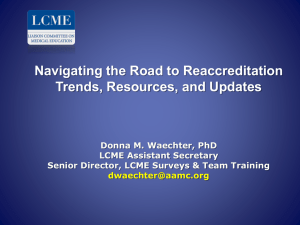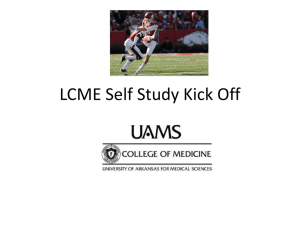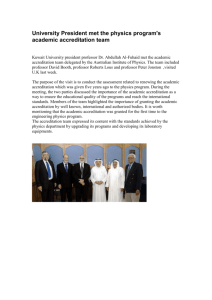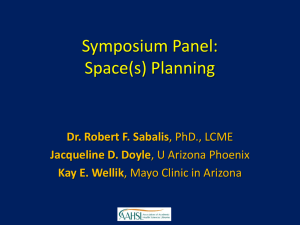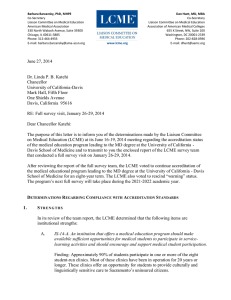LCME Accreditation Standards
advertisement
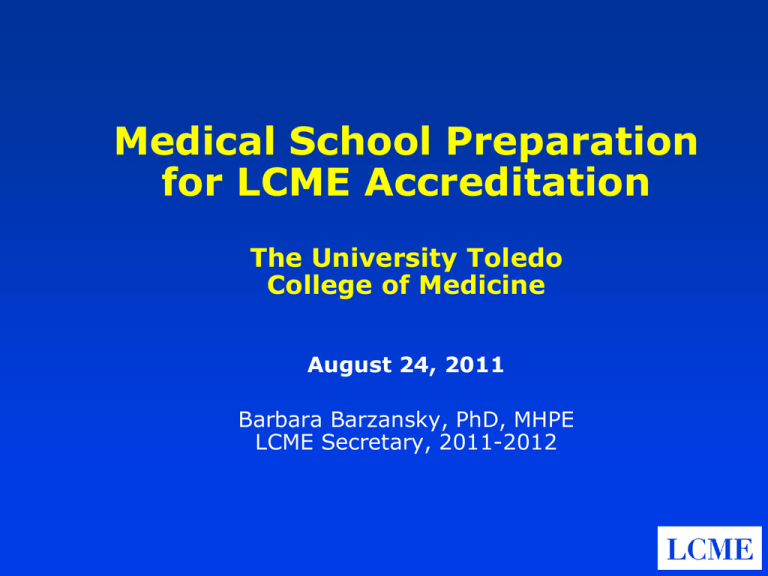
Medical School Preparation for LCME Accreditation The University Toledo College of Medicine August 24, 2011 Barbara Barzansky, PhD, MHPE LCME Secretary, 2011-2012 Goals of the Session • Describe the purpose of accreditation • Provide a summary of steps in the accreditation process • Describe commonly-cited standards and areas that are challenging for medical schools Purposes and Principles of Accreditation Accreditation is a review of an institution or program using a defined set of standards Accreditation in the U.S. includes the following components: • Self assessment based in standards • Peer review • Continuous quality improvement Self-Assessment The self-assessment component includes: • School collection of data related to accreditation standards - Medical Education Database - Student survey • Analysis of data by institutional stakeholders - Self-study committee reports/ Self-study executive summary - Independent student analysis LCME Accreditation Standards 129 standards organized into 5 categories: • Institutional setting • Educational program • Medical students • Faculty • Resources for the educational program Contained in Functions and Structure of a Medical School (May 2011) Timeline For a full survey visit: - Begin data collection (-15 months before visit) - Begin data analysis (-9/12 months) - Submit Database and Self-study (-3 months) - Begin developing survey schedule (-3 months) Consult with survey team secretary - Send data updates to team and Secretariat (-1 month) Parts of the Medical Education Database • A document with one or more questions linked to each accreditation standard • A document with a description of each course and clerkship • A copy of the most recent AAMC Graduation Questionnaire • A copy of the medical student independent analysis • A set of appendix materials (policies, documents) • An institutional self-study summary Select a Base Year for Data • Use a single base year for the Database (the most recently completed academic year) - You will need to update information in a number of areas before the visit (e.g., finances, faculty) • Contact the Secretariat AT ANY TIME (REALLY) with questions about how to complete the database. Contact should come from the self-study coordinator. Preparing the Database • Be accurate and complete (answer all questions and provide all the data requested), but be specific (avoid information not related to the question) • Avoid including excessive documentation (select documents carefully for the Appendix) • Large documents can be made available to the team on site (or, if necessary, provide files on disk or through a link) Independent Student Analysis • Data collected via a student-managed survey to all students • Participation by as many students as possible is important • Student committee analyzes survey data and independently composes a student report regarding strengths and areas of concern at the school • Dean’s office can offer support to students for data analysis, but otherwise this is an independent student effort Goals of the Self-study • Self-study allows an institutional assessment of compliance with accreditation standards - Schools are expected to identify strengths and challenges/areas needing improvement • This allows schools to develop plans and strategies to address problem areas before the visit and, if possible, implement change • A good self-study is when the findings of the school and the survey team are consistent Self-study Structure • Committees are organized, typically around the five sections of F&S with an executive (steering) committee • Each committee reviews the relevant sections of the database and answers questions in the Selfstudy Guide that are linked to specific standards - Outcome is a set of institutional strengths and problem areas/challenges • The steering committee creates a self-study summary document Peer Review The peer review component consists of: • Visit by an ad hoc survey team selected for the school - Identification of findings related to standards - Development of a survey report • Review of the survey report by the LCME The Purpose of a Visit from the Survey Team’s Perspective • Answer questions regarding compliance raised by the Database and Self-study • Fill in gaps in information • Verify information and impressions from the Database, Self-study, and Independent Student Analysis • Collect updated information The team will be trying to address the questions in the Survey Report Guide. Schools should consult the Guide as part of their preparation for the visit. Survey Team Composition • Chair • Secretary • Members (2) • Faculty Fellow The team is chosen based, in part, on the characteristics of the school and will include at least one member of the LCME or the LCME Secretariat Visit Schedule for the University of Minnesota • The schedule of the survey visit will allow the survey team to interact with a variety of groups (faculty, administrators, students) • The visit schedule will be developed by the school in collaboration with the survey team secretary Summary Survey Team Findings During the visit, the survey team will identify: • Areas of strength Particularly noteworthy areas that contribute in a major way to the achievement of the school’s mission or that could serve as models • Areas in compliance with monitoring 1) A medical education program has the policy, process, resource, or system required by a standard but there is insufficient evidence to indicate that it is effective; or 2) A medical education program currently is in compliance with a standard, but known circumstances exist that could lead to future noncompliance • Areas of noncompliance Survey Report Development The team will develop a draft report describing its findings related to compliance with each accreditation standard. The summary survey team findings will serve as the “executive summary ” of the survey report. The draft report will be reviewed sequentially by the LCME Secretariat and the dean before being finalized and sent to the LCME. Careful Report Review is Critical • The dean will review the draft report carefully - The final report will become the formal record of the visit and will be used by the LCME to make its accreditation decision • The dean will send feedback on errors of fact in the report to the team secretary in a timely manner • If there is a disagreement with the findings or tone of the report, the dean will send a letter to the LCME Secretariat to be shared with the LCME Possible LCME Actions Following a Full Survey Visit • Continue full accreditation for an eight-year term with no additional follow-up • Continue full accreditation for an eight-year term with one or more follow-up actions (written status reports, consultations) • Continue accreditation pending the outcome of a follow-up visit • Continue accreditation but place the program on warning of probation • Continue accreditation but place the program on probation • Withdraw accreditation Accreditation as a CQI activity Areas of Noncompliance Identified Next Full Review Follow-up Visit/Report Area Resolved Unresolved/ Further Follow-up LCME Review Average Number of Citations by Year of Survey Review Most Common Areas of Noncompliance from full surveys (n = 89) reviewed October, 2005 - June, 2010 1. ED-30 Timeliness of course and clerkship grades 2. ED-2 Central oversight clinical objectives 3. ER-9 Affiliation agreements 4. ED-33 Integrated institutional responsibility for curriculum 5. ED-8 Comparability of educational experiences & evaluation 6. MS-19 System to assist students’ career & electives choice and residency application 7. ED-24 Preparing residents as teachers 8. ED-35 Curriculum subject to periodic faculty review & revision 9. ED-31 Mid-course & clerkship feedback 10. ED-1 Ed. Program Objectives MS-24 Indebtedness ER-4 Facilities Secretariat Staff LCME: Dan Hunt (Secretary AAMC) Bob Sabalis (Ass’t. Sec. AAMC) Barbara Barzansky (Secretary, AMA) CACMS: Geneviéve Moineau (Secretary) Linda Peterson (Ass’t Secretary) LCME Documents • All relevant LCME documents are on the LCME Web site: www.lcme.org • Documents are updated regularly (so always check for the most recent version)
